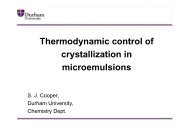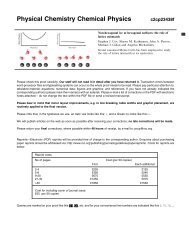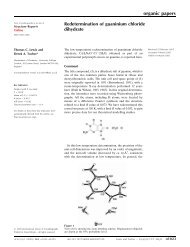ADVANCED USERS DMACRYS & NEIGHCRYS manual Manual ...
ADVANCED USERS DMACRYS & NEIGHCRYS manual Manual ...
ADVANCED USERS DMACRYS & NEIGHCRYS manual Manual ...
You also want an ePaper? Increase the reach of your titles
YUMPU automatically turns print PDFs into web optimized ePapers that Google loves.
Operands<br />
None<br />
CHGC<br />
The programs checks that the unit cell is neutral and will stop if it is not. Including the directive CHGC<br />
forces the program to continue with a non-neutral cell. DMAs generated by SCF programs often have a<br />
small residual charge, so this directive should be included and is set by <strong>NEIGHCRYS</strong>.<br />
CLUS<br />
Operands<br />
None<br />
This directive tells <strong>DMACRYS</strong> to switch off the Ewald sum and carry out charge-charge and charge-dipole<br />
interactions by direct summation. This can be used to work out the energy of a cluster by using a cell with<br />
artificially large lattice vectors.<br />
ZVAL<br />
Operand type<br />
I<br />
Operand name<br />
ZVAL<br />
ZVAL is the user-defined number of formula units per cell, used to calculate energies in kilojoules per mole.<br />
If ZVAL is not supplied, <strong>DMACRYS</strong> will try to read it from the fort.20 file.<br />
EXTN<br />
Operand type<br />
F<br />
Operand name<br />
EXTH<br />
This directive is used in conjunction with the Williams potential. If <strong>NEIGHCRYS</strong> uses the Williams<br />
potential, EXTN 0.1 will be written<br />
The Williams potential uses artificially shortened hydrogen bond lengths by moving the positions of the<br />
hydrogen atoms. This is to take some account of the effect of thermal motion in the crystal. If <strong>NEIGHCRYS</strong><br />
is used to set up the dmain file, the hydrogen atoms can be foreshortened by using the appropriate option in<br />
the <strong>NEIGHCRYS</strong> input. <strong>NEIGHCRYS</strong> always foreshortens the H atom positions by 0.1 Angstroms. The<br />
directive EXTN instructs <strong>DMACRYS</strong> to extend the hydrogen bond lengths by an amount EXTH Angstroms.<br />
This will be done before the final fdat and res files are written to units 15 and 16 respectively so that the job<br />
may be restarted to carry out a symmetry reduction or properties calculation without cumulative reductions<br />
in the H bond length taking place. EXTH should be set to 0.1 for datasets written by <strong>NEIGHCRYS</strong> but may<br />
need to be set to other values if the foreshortening is not 0.1.<br />
3.2.4 CUTOFFS<br />
CUTO<br />
Operand types F F <br />
Operand names RLSCAL CUTPOT ACCTH CUTTH<br />
CUTOFFS<br />
The repulsion-dispersion interactions which are calculated in <strong>DMACRYS</strong> are controlled by two cutoffs,<br />
CUTPOT and RDMA.<br />
RLSCAL gives the lattice constant c in Å. (See LATT and BASI directives and the examples following).<br />
Certain quantities are input in units of RLSCAL, referred to as lattice units.<br />
CUTPOT gives the repulsion-dispersion potential cutoff in lattice units. CUTPOT should not be equal to an<br />
interatomic distance in the crystal. This is because the test in the perfect lattice calculation may find one<br />
bond but leave out a symmetry related bond, giving perfect lattice tensor properties of the wrong symmetry.<br />
Usually it is safe just to ensure that CUTPOT does not equal an integral number of lattice vectors. (i.e. that<br />
CUTPOT is not an integer). <strong>NEIGHCRYS</strong> will set a default value of 15 Å.<br />
8







